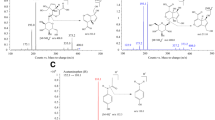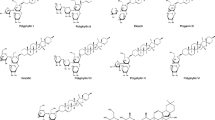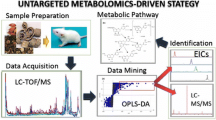Abstract
Objective
To investigate the relationship between tissue distributions of modified Wuzi Yanzong prescription (加味五子衍宗方, MWP) in rats and meridian tropism theory.
Methods
A high-performance liquid chromatography with Fourier transform-mass spectrometry (HPLC-FT) method was used to identify the metabolites of MWP in different tissues of rats after continued oral administration of MWP for 7 days. The relationship between MWP and meridian tropism theory was studied according to the tissue distributions of the metabolites of MWP in rats and the relevant literature.
Results
Nineteen metabolites, mainly flavanoid compounds, were detected in the different rat tissues and classified to each herb in MWP. Further, it was able to establish that the tissue distributions of the metabolites of MWP were consistent with the descriptions of meridian tropism of MWP available in literature, this result might be useful in clarifying the mechanism of MWP on meridian tropism. In the long run, these data might provide scientific evidence of the meridian tropism theory to further promote the reasonable, effective utilization, and modernization of Chinese medicine.
Conclusion
The tissue distributions of MWP in vivo were consistent with the descriptions of meridian tropism of MWP.
Similar content being viewed by others
References
Huang LM, Tang SH. Research on the origins and content of meridian tropism theory. J Trad Chin Med (Chin) 2009;50:680–682.
Zhao Y, Li Y, Wang X, Sun WJ. The experimental study of Cortex Eucommiae on meridian tropsim: the distribution study of aucubin in rat tissues. J Pharm Biomed Anal 2008;46:368–373.
Wang HM, Zhang SS, Zhao HZ. The present state and prospect of experimental study on channel tropism. J Shanxi Tradit Chin Med (Chin) 2000;16:48–50.
Wang J, Liang MX. Thoughts and methods of modern research on channel distribution of Chinese herbs. World Sci Tech/ Modern Tradit Chin Med Mat Med (Chin) 2012;14:1237–1241.
Fu H, Wang XM, Liu GX, Xie S, Guo XM, Li L, et al. Effects of modified Wu-Zi-Yan-Zong granule on memory ability and volume of hippocampus measured by MRI in patients with mild cognitive impairment. Chin J Integr Tradit West Med (Chin) 2006;26:1066–1069.
Fu X J, Liu H B, Wang P, Guan H S. A study on the antioxidant activity and tissues selective inhibition of lipid peroxidation by saponins from the roots of Platycodon grandiflorum. Am J Chin Med 2009;37:967–975.
Xu SN. Investing modern research on meridian-reaching actions of traditinal Chinese medicinal herbs. Chin J Pharmacol Bull (Chin) 2004;20:598–600.
Wang T, Guan JH. Views of study of channel tropism of Chinese herb and disease. J Tradit Chin Med (Chin) 2012;53:356–357.
Zhou J. New understanding of the basic theory of traditional Chinese medicine. Chin J Integr Med 2009;15:7–12.
The Pharmacopoeia Commission of P.R. China. The Chinese pharmacopoeia. Beijing: China Medical Science Press; 2010:61-64, 232-233, 290-291, 306-307, 359.
Wu MS, Li E, Zhao SZ. Influence of kidney-nourishing compound formula on intracellular information regulation in rats with osteoporosis and experimental study on correlation of meridian-tropism of herbal drugs. Shanghai J Trad Chin Med (Chin) 2000;2:44–46.
Li L, Tsai HJ, Li L, Wang XM. Icariin inhibits the increased inward calcium currents induced by amyloid-beta(25-35) peptide in CA1 pyramidal neurons of neonatal rat hippocampal slice. Am J Chin Med 2010;38:113–125.
Zeng KW, Ko H, Yang HO, Wang X M. Icariin attenuates beta-amyloid-induced neurotoxicity by inhibition of tau protein hyperphosphorylation in PC12 cells. Neuropharmacology 2010;59:542–550.
Yan BY, Pan CS, Mao XM, Yang L, Liu YY, Yan L, et al. Icariside II improves cerebral microcirculatory disturbance and alleviates hippocampal injury in gerbils after ischemiareperfusion. Brain Res 2014;1573:63–73.
Wang Z, Zhang X, Wang H, Qi L, Lou Y. Neuroprotective effects of icaritin against beta amyloid-induced neurotoxicity in primary cultured rat neuronal cells via estrogendependent pathway. Neuroscience 2007;145:911–922.
Zhang LM, Yang J, Li YQ, Gong QH, Yang DL. Antimyocardial fibrosis activity of icariin in pressure overload rats through inhibition of TGF beta1/Smad2 signal pathway. Chin J Pharmacol Bull (Chin) 2013;29:99–102.
Li J, Liu P, Zhang R, Cao L, Qian H, Liao J, et al. Icaritin induces cell death in activated hepatic stellate cells through mitochondrial activated apoptosis and ameliorates the development of liver fibrosis in rats. J Ethnopharmacol 2011;137:714–723.
Gupta R, Sharma V. Ameliorative effects of tinospora cordifolia root extract on histopathological and biochemical changes induced by aflatoxin-b(1) in mice kidney. Toxicol Int 2011;18:94–98.
Choi JH, Kim DW, Yun N, Choi JS, Islam MN, Kim YS, et al. Protective effects of hyperoside against carbon tetrachlorideinduced liver damage in mice. J Nat Prod 2011;74:1055–1060.
Li ZL, Hu J, Li YL, Xue F, Zhang L, Xie JQ, et al. The effect of hyperoside on the functional recovery of the ischemic/ reperfused isolated rat heart: potential involvement of the extracellular signal-regulated kinase 1/2 signaling pathway. Free Radic Biol Med 2013;57:132–140.
Zeng KW, Wang XM, Ko H, Kwon HC, Cha JW, Yang HO. Hyperoside protects primary rat cortical neurons from neurotoxicity induced by amyloid beta-protein via the PI3K/ Akt/Bad/Bcl(XL)-regulated mitochondrial apoptotic pathway. Eur J Pharmacol 2011;672:45–55.
Shi H, Dong L, Jiang J, Zhao J, Zhao G, Dang X, et al. Chlorogenic acid reduces liver inflammation and fibrosis through inhibition of toll-like receptor 4 signaling pathway. Toxicology 2013;303:107–114.
Kim MS, Kim SH. Inhibitory effect of astragalin on expression of lipopolysaccharide-induced inflammatory mediators through NF-kappa B in macrophages. Arch Pharm Res 2011;34:2101–2107.
Bunel V, Antoine MH, Nortier J, Duez P, Stevigny C. Protective effects of schizandrin and schizandrin B towards cisplatin nephrotoxicity in vitro. J Appl Toxicol 2013;34:1311–1319.
Xie Y, Hao H, Wang H, Guo C, Kang A, Wang G. Reversing effects of lignans on CCl4-induced hepatic CYP450 down regulation by attenuating oxidative stress. J Ethnopharmacol 2014;155:213–221.
Chang RM, Li Y, Yang XX, Yue Y, Dou LL, Wang YW, et al. Protective role of deoxyschizandrin and schisantherin A against myocardial ischemia-reperfusion injury in rats. PLoS One 2013;8:e61590.
Li L, Zhang T, Zhou L, Xing G, Chen Y, Xin Y. Schisandrin B attenuates acetaminophen-induced hepatic injury through heat-shock protein 27 and 70 in mice. J Gastroenterol Hepatol 2014;29:640–647.
Khan MM, Ahmad A, Ishrat T, Khuwaja G, Srivastawa P, Khan MB, et al. Rutin protects the neural damage induced by transient focal ischemia in rats. Brain Res 2009;1292:123–135.
Rajamani K, Renju V C, Sethupathy S, Thirugnanasambandan SS. Ameliorative effect of polyphenols from Padina boergesenii against ferric nitrilotriacetate induced renal oxidative damage: with inhibition of oxidative hemolysis and in vitro free radicals. Environ Toxicol 2014.
Zhang N, Hua Y, Wang C, Sun Y, Wang Z, Liu Z, et al. Distribution study of tryptanthrin in rat tissues by HPLC and its relationship with meridian tropism of indigo naturalis in traditional Chinese medicine. Biomed Chromatogr 2014;28:1701–1706.
Zeng KW, Zhang T, Fu H, Liu GX, Wang XM. Modified Wu-Zi- Yan-Zong prescription, a traditional Chinese polyherbal formula, suppresses lipopolysaccharide-induced neuroinflammatory processes in rat astrocytes via NF-kappaB and JNK/p38 MAPK signaling pathways. Phytomedicine 2012;19:122–129.
Author information
Authors and Affiliations
Corresponding author
Additional information
Supported by the National Natural Science Foundation of China (Nos. 81102683, 30973813 and 81173369), the Doctoral Fund of the Ministry of Education of China (Nos. 20110001120055 and 20120001110105), and the Natural Science Foundation of Beijing City (No. 7132210)
Electronic supplementary material
Rights and permissions
About this article
Cite this article
Wang, Ll., Li, Ww., Wu, Cs. et al. Relationship between Tissue Distributions of Modified Wuzi Yanzong Prescription (加味五子衍宗方) in Rats and Meridian Tropism Theory. Chin. J. Integr. Med. 24, 117–124 (2018). https://doi.org/10.1007/s11655-016-2270-2
Received:
Published:
Issue Date:
DOI: https://doi.org/10.1007/s11655-016-2270-2




